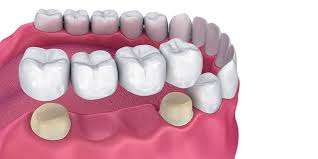Modern dental advances provide a host of options for tooth replacement-from traditional dentures to crowns & bridges (metal ceramic and metal free ceramics) to the latest dental implants.
Why replace a missing tooth?
In a normal, healthy mouth, chewing function is well balanced since each upper tooth has proper contact and function with corresponding lower teeth. Because of this natural proper balance, undue strain or irritation on the gum tissue and bone is non-existent. Drifting or spreading of teeth does not occur and oral hygiene is easily maintained. But, this natural proper balance is quickly destroyed when a tooth is lost.
This is what can happen:

- The opposing molar may super-erupt.
- The unprotected ridge is subject to trauma.
- The neighbor teeth tilt and proper functional balance is destroyed.
- The drifting teeth create food impact areas where decay starts or where Periodontal Disease can start.
- Destruction to the bone will result as teeth drift and tip.
The loss of teeth is associated with diminished self-confidence and of course chewing difficulties. So, it is necessary to replace the missing teeth as early as possible with something that resembles your natural teeth to the maximum. With recent developments in dentistry, a number of options are now available to the patients to choose from.
Fixed Teeth
Patients willing to get replacements via fixed teeth may opt for crowns and bridges or for dental implants.
Dental Crowns and Bridges
Simply stated, a dental crown is a tooth cap placed to cover the tooth to restore its shape, its size and its strength. A bridge is a combination of crowns.
A dental crown may be advised to:
- protect a weak tooth (for instance, from decay) from breaking especially after an RCT
- restore an already broken tooth or a tooth that has been severely worn down
- cover and support a tooth with a large filling when there isn’t a lot of tooth left
- hold a dental bridge in place
- cover misshaped or severely discolored teeth
- over a dental implant
Dental bridges are meant to replace missing teeth by “bridging” the gap between two remaining teeth. This involves creation of a pontic, or false tooths with a dental crown on either side. The crowns are fitted over the remaining teeth to hold the false tooth in place.
When there are only teeth on one side of the gap, cantilever bridges may be given. cantilever bridges consist of two side-by-side crowns and only one is connected to the pontic.
A fixed bridge helps to

- Replace missing tooth/teeth.
- Helps balance a normal bite.
- Helps prevent undesirable stress on the dental ridge.
- Prevents over-eruption of the opposing teeth.
- Prevents drift and tilt of adjacent teeth.
- Prevents tooth decay in adjacent drifted teeth
- Retards onset of gum diseases
These crowns and bridges require a bit of extra care in terms of oral hygiene. With such care, bridges can last up to several years. However, improper or infrequent brushing and flossing, irregular dental visits, and excessive sugar and starch intake can all bring untimely damage to the bridge
Dental Implants
Missing teeth, single or multiple can be best replaced with dental implants. A dental implant is a small titanium screw that serves as the replacement for the root portion of a missing natural tooth. The screw is painlessly placed inside the jaw bone and left to heal. The healing period varies from patient to patient depending on bone quality and quantity. Once the implant fuses with the bone, an artificial tooth is attached to the implant.
Dental Implants may be used to replace one or more missing teeth. In case of completely edentulous patients, implants may be used to fix the dentures to the underlying bone. Needless to say, an implant offers several advantages over conventional treatment options. The benefits of implant treatment include improved appearance and self-esteem as well the enhanced ability to chew and enjoy your food, coupled with protection of your remaining teeth and jawbone.
The only disadvantage is that the dental implants are costly and the time involved in the entire treatment.
Dentures
This is the most economic and most traditional method of tooth replacement. Dentures are removable objects that simulate the look and function of the tooth and its surrounding tissue. Most dentures are constructed with acrylic resins along with some composite materials.
There are two major types of dentures. The full denture replaces an entire jaw’s dentition, while a partial denture only replaces multiple or single teeth where there are still healthy teeth present. A partial denture also serves as a spacer to prevent the living teeth from shifting position. However patient can chose from a variety of options:
- Traditional plastic denture
- Traditional plastic denture with a metal framework to make the denture strong, light and of course biocompatible.
- Flexible denture(valplast)
Dentures can also be fixed now by use of dental implants.
To Know more about our tooth replacement options and the one best suited to you, Contact us today!
